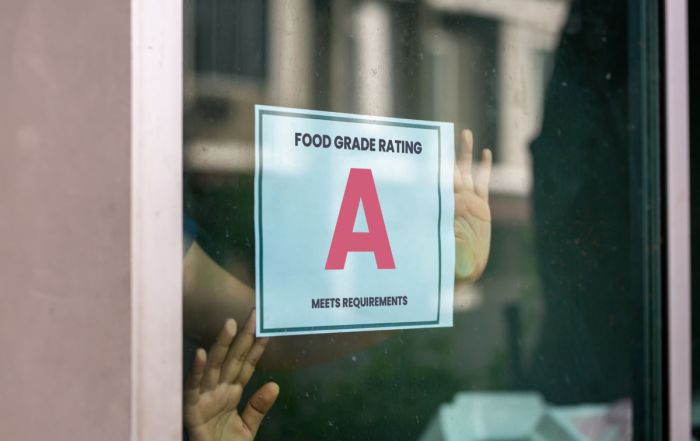Mitigating Risk in the Overall Food Safety System
In the 1990s, when I took my first food safety class, we learned about a new system called HACCP. Ok, maybe it wasn’t that new, but it sure seemed new at the time. My memory has certainly faded since that class in 1997, but I do recall our discussion in the class about how HACCP would become the norm for all foodservice establishments in the future. Fast forward almost 25 years and the only foodservice operation mandated to have a HACCP program is school foodservice – certainly not the widespread adoption that we thought might come about.
While HACCP is not required in all foodservice operations, the main idea behind HACCP is to manage and mitigate risks that you have specific to your foodservice operation. Essentially, it uses the risks we might foresee to help guide our decisions in producing food to protect public health. In other words, we implement mitigation strategies where necessary to keep food safe. A sushi restaurant will have different mitigation strategies than a fast-food operation, and both will have different strategies than a school foodservice, which mostly uses assembly-serve production. So, while HACCP isn’t nearly as widespread as we thought it might be in the 1990s, some of the most integral parts to the HACCP system have been adopted in many organizations, such as risk analysis and mitigation.
A key element the inspector is looking for is active managerial control, where the food service manager is attempting to prevent the risk of foodborne illness, rather than just reacting to it when an employee, or the inspector, points it out.
The use of a risk analysis framework is not only seen in our operations, but the science-based underpinning of risk analysis is what has driven our food safety system. Look no further than the FDA Food Code and the importance of risk factors on driving inspection standards. You will likely notice some of the key items your inspector looks for during your most recent inspection have likely changed from what they were four or five years ago. Recent inspections tend to focus on five key areas, which if you have read this blog before you have likely heard us mention. These are,
- Food from unsafe sources,
- Inadequate cooking,
- Improper holding temperatures,
- Contaminated equipment, and
- Poor personal hygiene.
Another key element the inspector is looking for is active managerial control, where the food service manager is attempting to prevent the risk of foodborne illness, rather than just reacting to it when an employee, or the inspector, points it out. Active managerial control can take many forms, and we will discuss more of these in our first blog in November.
Our next SafeBites Webinar is quickly approaching and is scheduled for November 17 at 1:00 pm. Please pencil it in and plan to join us. If you have any topics for upcoming SafeBites webinars, please feel free to reach out, I am always looking for topics of interest to those who attend. In the meantime, have a safe Halloween. Risk Nothing.
READ MORE POSTS
Quat Binding – Why this Can Have a Disastrous Impact on Your Sanitation Program.
In June, I had the opportunity to represent FoodHandler and speak on food safety behavior for customers of Martin Bros. Distributing in Waterloo, Iowa. One of the questions that was asked caught me a little off guard. The question was about quat binding. It caught me off guard not because it was a bad question, but only because it was not something I had previously been asked nor had not yet been exposed to the phenomenon. However, I soon learned that in certain jurisdictions, it is resulting in changes to how sanitizing cloths are to be stored in sanitizing buckets (or not) in the foodservice industry. When I returned home from the trip, I had to dig into it to learn about what quat binding is and how it might impact foodservice operations.
Are Grades for Foodservice Inspections a Good Idea?
I generally try to stay away from controversial topics in my blog, but this is one I thought it might be interesting to discuss. Occasionally on my travels, I will come across a state or a local jurisdiction that requires foodservice inspection scores be posted in the window of the establishment. The idea is to allow would-be customers the ability to see how the foodservice operation in which they are about to eat scored on their latest health inspection.
Neglected Safety: CDC Report Casts Doubts on the Ability of the Foodservice Industry to Ensure Ill Workers Stay at Home
Early in June, the Centers for Disease Control and Prevention released a report outlining foodborne illness outbreaks in retail foodservice establishments. The report outlined outbreaks from 25 state and local health departments from 2017 through 2019.
Keeping Food Safe While Serving Outdoors
This afternoon I met some friends for lunch and as I drove through our beautiful downtown area in Manhattan, KS, I noticed that many people were taking advantage of the gorgeous weather and dining outside with friends. For our local community - outdoor dining is one of the remnants of COVID that we actually have come to enjoy on beautiful days. With spring in full swing and summer just around the corner, many foodservice operations are taking advantage of the warm weather by offering outdoor dining options.










